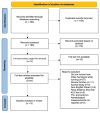Foot-strike Hemolysis: A Scoping Review of Long-Distance Runners
- PMID: 39758544
- PMCID: PMC11698231
- DOI: 10.17161/kjm.vol17.22146
Foot-strike Hemolysis: A Scoping Review of Long-Distance Runners
Abstract
Objective: To investigate the role that foot-strike hemolysis plays in sports-related anemia in marathon and ultramarathon runners.
Data sources: PubMed, Embase, Cochrane, Grey literature.
Study selection: Inclusion criteria consisted of human studies with runners completing a sanctioned race of marathon distance or greater, with outcomes measured by pre- and post-race hematological assessments.
Data extraction: Three independent reviewers systematically extracted data from selected studies. Data included age, sex, height, weight, best marathon time, and pre- and post-race outcomes for complete blood count, reticulocyte count, and iron studies. The evaluation of potential bias was conducted using the Methodological Index for Nonrandomized Studies (MINORS) criteria.
Data synthesis: The literature search yielded 334 studies, of which nine met the inclusion criteria, encompassing data from 267 runners. The majority (88%, 236 out of 267) were male, with a weighted mean age of 37 years (SD 8.2). The reticulocyte count demonstrated a 16% increase between pre- and post-race measurements, although still within normal limits, while haptoglobin levels were reduced by 21%. Hemoglobin, hematocrit, and RBC count values remained within accepted normal limits.
Conclusions: Changes in reticulocyte count and haptoglobin levels suggest transient foot-strike hemolysis; however, hemoglobin and hematocrit levels did not change notably. It is unclear whether these associations are influenced by differences in runner demographics, running experience, or race characteristics. Further studies should evaluate hemolytic changes while matching participants by demographic characteristics, level of running experience, and specific marathon course characteristics. Additionally, research should analyze whether intravascular hemolysis occurs at race distances shorter than 42.2 km.
Keywords: anemia; athletes; exercise; hemolysis; marathon running.
Copyright © 2024 Gartner, et al.
Conflict of interest statement
Disclosure: The authors of this study declare that they have no financial interests or conflicts of interest related to the content of this study.
Figures
References
-
- Chiu YH, Lai JI, Wang SH, et al. Early changes of the anemia phenomenon in male 100-km ultramarathoners. J Chin Med Assoc. 2015;78(2):108–113. - PubMed
-
- Kast A. Ueber paroxysmale hämoglobinurie durch gehen. DMW - Deutsche Medizinische Wochenschrift. 1884;10(52):840–842. doi: 10.1055/s-0028-1143431. - DOI
Publication types
LinkOut - more resources
Full Text Sources
Miscellaneous

